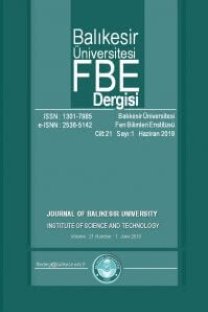Pt (111) yüzeyi ile hidrojen atomunun etkileşimi için LEPS potansiyel enerji yüzeyinin incelenmesi
Investigation of LEPS potential energy surface for the interaction of a Pt(111) surface with a hydrogen atom
Potential energy surface, LEPS, Pt(111) surface adsorption,
___
- Olsen, R. A., Kroes, G. J. and Baerends, E. J., Atomic and molecular hydrogen interacting with Pt(111), The Journal of Chemical Physics.,111, 11155-11163, (1999).
- Watson, G. W., Wells, R. P. K., Willockand, D. J. and Hutchings, G. J., ab initio simulation of the interaction of hydrogen with the {111} surfaces of platinum, palladium and nickel: A possible explanation for their difference in hydrogenation activity, Chemical Communications, 8, 705-706, (2000).
- Nobuhara, K., Nakanishi, H., Kasai, H., and Okiji, A., Interactions of atomic hydrogen with Cu(111), Pt(111), and Pd(111), Journal of Applied Physics, 88, 6897-6901, (2000).
- Nobuhara, K., Nakanishi, H., Kasai, H., and Okiji, A., Quantum mechanical behavior of an H atom on Cu(111) and Pt(111), Journal of Applied Physics, 91, 1855-1859, (2002).
- Nobuhara, K., Nakanishi, H., Kasai, H., and Okiji, A., Behavior of H atom in adsorption states on metal surfaces—localization and delocalization, Surface Science, 493, 271-277, (2001).
- Ludwig, J. and Vlachos, D. G., First principles modeling of dissociative adsorption at crystal surfaces: hydrogen on Pt(111), Molecular Simulation, 30 (11-12), 765-771, (2004).
- Vehviläinen, T., Salo, P., Ala-Nissilaand, T. and Ying, S. C., Electronic properties of H on vicinal Pt surfaces: First-principles study, Physical Review B: Condensed Matter, 80, 035403, (2009).
- Vurdu, C. D., Cavus, M. S. and Kandemirli, F., Investigation of H(2H) - Pt(111) interaction system: using density functional methods, 3rd International Conference on Computation for Science and Technology (ICCST-3), Advances in Computer Science Research, ISBN:978-94-62520-46-2, ISSN: 2352-538x 144-148, (2015).
- Marchetti, J. M., González, E., Jasen, P., Brizuela, G. and Juan, A., Hydrogen adsorption and diffusion on a Pt(111) cluster, Surface Review and Letters, 15, 319-327, (2008).
- Pašti, I. A., Gavrilov, N. M. and Mentus, S. V., Hydrogen adsorption on palladium and platinum over layers: DFT study, Advances in Physical Chemistry, 2011 Article ID 305634, 8 pages, (2011).
- Ludwig, J., Vlachos, D. G., vanDuin, A. C. T. and Goddard, W. A., Dynamics of the dissociation of hydrogen on stepped platinum surfaces using the ReaxFF reactive force field, The Journal of Physical Chemistry B, 110, 4274-4282, (2006).
- Güvenç, Z. B., Sha, X. and Jackson, B., Eley–Rideal and hot atom reactions between hydrogen atoms on Ni(100): Electronic structure and quasi classical studies, The Journal of Chemical Physics, 115, 9018-9027, (2001).
- Jackson, B., Sha, X. and Güvenç, Z. B., Kinetic model forEley–Ridealand hot atom reactions between H atoms on metal surfaces, The Journal of Chemical Physics, 116, 2599-2608, (2002).
- Güvenç, Z. B., Sha, X. and Jackson, B., The effects of lattice motion on eley-rideal and hot atom reactions: quasi classical studies of hydrogen recombination on Ni(100), The Journal of Physical Chemistry B, 106 (33), 8342–8348, (2002).
- Güvenç, Z. B. and Güvenç, D., Hydrogen recombination on a mixed adsorption layer at saturation on a metal surface: H → (D + H)sat + Ni(100), Surface Science, 529 (1-2), 11–22, (2003).
- Shalashilin, D. V., Jackson, B., and Persson, M., Eley–Rideal and hot-atom dynamics of HD formation by H(D) incident from the gas phase on D(H)-covered Cu(111), Faraday Discussions, 110, 287-300, (1998).
- Persson, M., Strömquist, J., Bengtsson, L., Jackson, B., Shalashilin, D. V., and Hammer, B., A first-principles potential energy surface for Eley–Rideal reaction dynamics of H atoms on Cu(111), The Journal of Chemical Physics, 110, 2240-2249, (1999).
- Shalashilin, D. V., Jackson, B. and Persson, M., Eley–Rideal and hot-atom reactions of H(D) atoms with D(H)-covered Cu(111) surfaces; quasi classical studies, The Journal of Chemical Physics, 110, 11038-11046, (1999).
- Vurdu, C. D., Özçelik, S. and Güvenç, Z. B., Quasi classical studies of Eley–Rideal and hot-atom reactions on a surface at 94 K: H(D) → D(H) + Cu(111), Surface Science, 601 (18), 3745–3749, (2007).
- Vurdu, C. D. and Güvenç, Z. B., H(D) → D(H) + Cu(111) collision system: Molecular dynamics study of surface temperature effects, The Journal of Chemical Physics, 134 (16), 164306, (2011).
- Vurdu, C. D. and Güvenç, Z. B., Developing interaction potential for H (2H) → Cu(111) interaction system: A numerical study, Communications in Nonlinear Science and Numerical Simulation, 15 (3), 648–656, (2010).
- Voter, A. F., Embedded atom method potentials for seven fcc metals: Ni, Pd, Pt, Cu, Ag, Au and Al, Los Alamos Unclassified Technical Report LA-UR 93-3901, 242, (1993).
- ISSN: 1301-7985
- Yayın Aralığı: 2
- Başlangıç: 1999
- Yayıncı: Balıkesir Üniversitesi
Semra SAYGIN, Melek ÖZPİÇAK, Aykut AYDIN, Enes HANÇER, Savaş YILMAZ, Nazmi POLAT
Gülçin ULUNEHİR AYDIN, Zeliha ERDOĞAN
Ayşenur YILDIRIM, Ayşe Gül ŞEKERCİOĞLU, Hasene Esra YILDIRIR
Mikrodalga destekli reaktörde pilot ölçekli rafine ve atık ayçiçek yağından biyodizel üretimi
Veli Gökhan DEMİR, Nadir İLTEN, Hakan Serhad SOYHAN
Ortalama farksal gelişim algoritması ile bilineer sistem kimliklendirme
Sonlu bir bölge üzerinde Atangana-Baleanu türevli adveksiyon-difüzyon denklemine analitik çözümler
Emre TEKOĞLU, Duygu AĞAOĞULLARI, Hasan GÖKÇE, M. Lütfi ÖVEÇOĞLU
Güneş pilleri için ZnO'nun yapısal ve elektronik özelliklerinin incelenmesi: Ab-initio çalışması
Genişletilmiş modüler grubun H ̅_3,3 alt grubu ve Fibonacci sayıları
